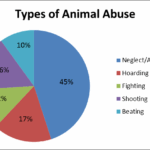Does South Dakota have robust animal cruelty laws? As many pet owners and animal lovers might ponder, this inquiry leads to a deeper exploration of the state’s legislative landscape in relation to animal welfare. While many states have made remarkable strides in securing the rights of animals and punishing those who commit acts of cruelty, we must examine whether South Dakota keeps pace with its counterparts. This article takes a comprehensive look at animal cruelty laws across the United States, with particular emphasis on South Dakota, highlighting the gaps and challenges that exist.
To understand the depth of animal cruelty laws in South Dakota, we first need to define what constitutes animal cruelty. Generally, animal cruelty can be categorized into two primary forms: neglect and intentional harm. Neglect occurs when an animal is deprived of necessary care, such as food, water, shelter, or medical treatment. Intentional harm encompasses purposeful actions aimed at inflicting pain or suffering on an animal. Recognizing these distinctions is crucial in assessing the legal framework surrounding animal welfare in South Dakota.
South Dakota’s animal cruelty laws are encapsulated in the South Dakota Codified Laws, primarily under Title 40, which addresses the welfare of domestic animals. The statutes delineate various forms of cruelty, establishing that causing harm or suffering to any animal is prohibited. These laws include provisions for both felony and misdemeanor penalties depending on the severity and circumstances surrounding the offense. However, upon closer inspection, the provisions exhibit certain inadequacies, leading critics to question their effectiveness.
For instance, while the law does address the active infliction of cruelty, it remains somewhat vague regarding the enforcement mechanisms and the responsibilities of pet owners. To illustrate, if a pet owner neglects their animal by failing to provide adequate food or medical attention, the repercussions may not reflect the gravity of the offense. This raises a pivotal challenge: are the punishments meted out truly sufficient to deter potential offenders? In many cases, the current penalties may not serve as a strong enough deterrent, resulting in a continuation of neglectful practices.
One noteworthy aspect of South Dakota’s legal approach is its failure to recognize animal cruelty as a standalone offense worthy of consistent judicial scrutiny across all county jurisdictions. This leads to a disjointed enforcement landscape where some counties may address cases more rigorously than others. Consequently, the vulnerability of animals in abusive situations is compounded by the inconsistency of legal enforcement, leaving many animals at the mercy of their owners.
In contrast, states like California and New York have made substantial advancements in their animal welfare laws, establishing stricter penalties and comprehensive guidelines for the treatment of animals. They provide mechanisms for whistleblowers to report abuse, creating a culture of accountability. Such initiatives have catalyzed significant improvements in animal welfare, fostering a proactive stance against cruelty. The question arises: what challenges prevent South Dakota from adopting similar progressive measures?
Part of the issue stems from the cultural norms that permeate regions like South Dakota. In a state with a robust agricultural background, some residents may view animals primarily as livestock rather than sentient beings deserving of protection. This perspective complicates the perception of animal cruelty and can stymie legislative advances aimed at enhancing animal welfare. Bridging the gap between traditional practices and modern understandings of animal rights poses a formidable task for advocates seeking reform.
Furthermore, public awareness and engagement play pivotal roles in influencing legislative action. A population that is unaware of the importance of strong animal welfare laws is less likely to advocate for change. Educating the public about the consequences of animal cruelty, the importance of compassionate treatment, and the legal recourse available are essential steps toward fostering a more humane environment for animals.
As advocates for animals in South Dakota continue their fight against cruelty, it is crucial to emphasize the role of organizations dedicated to this cause. Groups like South Dakotans Fighting Animal Cruelty Together mobilize resources to promote education, provide rescue services, and advocate for more stringent laws. By creating a strong coalition of concerned citizens, these organizations aim to challenge the status quo, igniting conversations that invoke change.
Transitioning from a reactive to a proactive framework in animal welfare necessitates a unified effort. The dynamic between individuals, organizations, and lawmakers must be strengthened to ensure the consistent application of animal cruelty laws. Encouraging discussions, public forums, and educational campaigns can serve to galvanize communities towards a shared goal of improvement.
In summation, while South Dakota does have laws in place addressing animal cruelty, significant challenges remain. The existing framework can be perceived as insufficient due to vague definitions and lenient penalties, coupled with cultural norms that prioritize agricultural practices over animal welfare. A push for change demands collaborative efforts from advocates, lawmakers, and the public to create a more humane society for animals. The time has come to reconsider the questions surrounding animal rights, ensuring South Dakota decisively steps toward becoming a leader in the protection of its most vulnerable residents. Will the state rise to the occasion, or will animals continue to suffer under the weight of outdated laws and ineffective enforcement?






